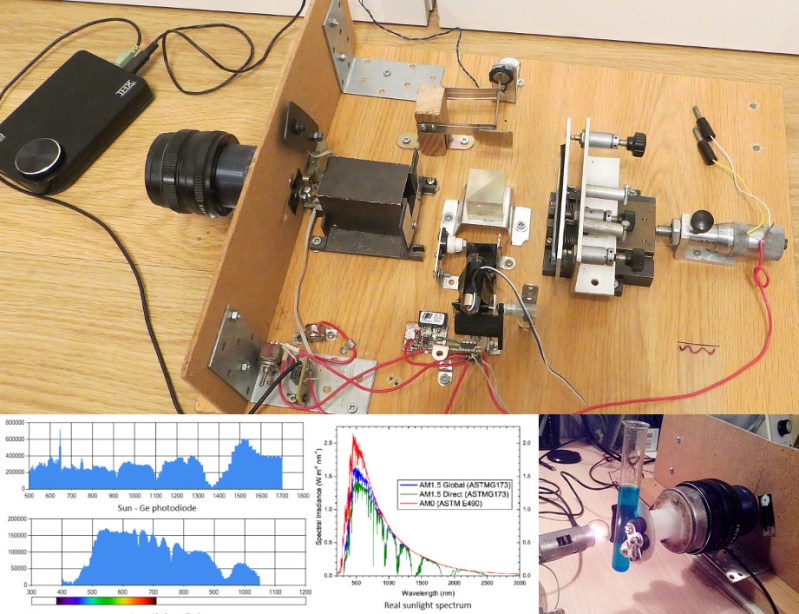Typical spectrometers use prisms or diffraction gratings to spread light over a viewing window or digital sensor as a function of frequency. While both prisms and gratings work very well, there are a couple of downsides to each. Diffraction gratings produce good results for a wide range of wavelengths, but a very small diffraction grating is needed to get high-resolution data. Smaller gratings let much less light through, which limits the size of the grating. Prisms have their own set of issues, such as a limited wavelength range. To get around these issues, [iliasam] built a Fourier transform spectrometer (translated), which operates on the principle of interference to capture high-resolution spectral data.
[iliasam]’s design is built with an assortment of parts including a camera lens, several mirrors, a micrometer, laser diode, and a bunch of mechanical odds and ends. The core of the design is a Michelson interferometer which splits and recombines the beam, forming an interference pattern. One mirror of the interferometer is movable, while the other is fixed. [iliasam]’s design uses a reference laser and photodiode as a baseline for his measurement, which also allows him to measure the position of the moving mirror. He has a second photodiode which measures the interference pattern of the actual sample that’s being tested.
Despite its name, the Fourier transform spectrometer doesn’t directly put out a FFT. Instead, the signal from both the reference and measurement photodiodes is passed into the sound card of a computer. [iliasam] wrote some software that processes the sampled data and, after quite a bit of math, spits out the spectrum. The software isn’t as simple as you might think – it has to measure the reference signal and calculate the velocity of the mirror’s oscillations, count the number of oscillations, frequency-correct the signal, and much more. After doing all this, his software calculates an interferogram, performs an inverse Fourier transform, and the spectrum is finally revealed. Check out [iliasam]’s writeup for all the theory and details behind his design.

















This looks like an amazing project but the translated link is broken and I can’t find the original site.
Would you correct that and delete this comment after you’ve done that?
Thanks.
I get a 404 error. Would you please fix the link. (Don’t link to the dynamic translated page. Link to the original and offer a translate option if you want.)
Great build! I also like the optical bench grade piece of wood chosen for this setup.
now this is a hack! and also science!
There’s gotta be an Arduino in there somewhere…
http://m.habrahabr.ru/post/253947/
Thanks [Daniel], and I’m sure [Ethan] will thank you as well if he ever figures out what he did wrong. ;-)
No Gayduino was used…and Im glad for this fact. He used the soundcard to capture all of his data
Why glad? That bitter?
Ever actually make anything, ever?
Smaller apertures are needed for higher resolution, not a smaller grating. That is what limits the light.
Cool! I’ve been wanting to do FTIR spectroscopy for a while… but I’m way to lazy to go beyond the fourier transform integral.
Internet Archive link: http://web.archive.org/web/20150415003724/http://m.habrahabr.ru/post/253947/
I am interested in constructing my own FTIR-spectrometer. Does anyone know where one can find cheap IR beamsplitters and mirrors? Can’t seem to find any .. seems this might not be a suitable hobby project after all.
Hey Christopher, dunno if you ever read this, but I’m thinking about building one based on a FLIR Lepton as detector, i.e. 8 – 14um band.
(Lepton instead of a simple FIR thermometer sensor as the final goal is a FTIR hyperspectral imager – although I’ll likely run out of steam long before I’m there)
Based on my preliminary experiments, in this band simple glass plates can be used used as mirrors, and a plastic bag (pulled tight and flat) can act as a beam splitter. Lenses are available cheaply from eBay and AliExpress for CO2 laser cutters.
If you’re into SWIR things might be different, though. Haven’t researched that nor experimented in that range.
NIR is simpler, as many standard optical materials are still transparent.
Made a comment regarding slicing biological samples and now @Christoffer – Dakk you have me wondering about growing crystals and cutting them with a precision cutting disc for semiconductors maybe and polishing to make custom optics? Then coating with the relative frequency range of interest optimal material… gold or silver I’m guessing offhand.
Fun with regions of the electromagnetic spectrum and material science nuclear/electric/magnetic/electromagnetic/plasma data clearly available regarding performance throughout the whole electromagnetic spectrum.
Cd DVD players